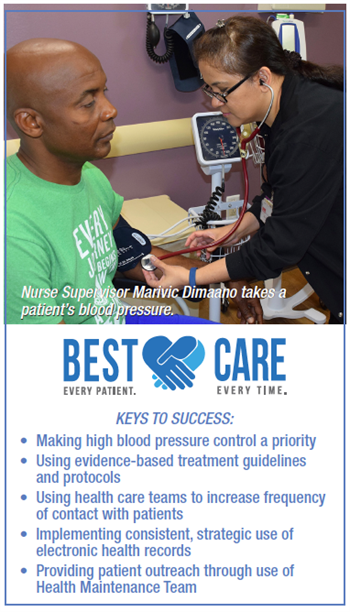
In less than a year, UTMB’s ambulatory clinics have gotten to the heart of a big health issue: hypertension. It’s often symptomless, but can be a dangerous disease—leading to stroke, heart attack, heart failure and kidney disease.
With that in mind, UTMB’s system of ambulatory clinics committed themselves to increase the percentage of hypertension patients whose blood pressure (BP) is under control from 65 to 70 percent. (“Under control” means having a blood pressure reading less than 140/90.)
“It was no easy task, but we took a team approach and developed a clinical education program to make sure we were successful,” said Michelle Millard, clinical nurse educator. “UTMB has more than 90 clinics that extend from McAllen to Orange, so this was a huge initiative.”
Starting on World Hypertension Day in May last year, the ambulatory team kicked off the initiative, encouraging all staff to review an article on best practices in hypertension.
“We followed up by asking everyone in ambulatory to have their blood pressure taken—and not just clinical staff, but also patient service specialists, our clerical personnel and physicians—so everyone would have their own measurement as a personal baseline and recognize the importance of knowing their blood pressure,” said Katherine Golden Beck, professional practice director for ambulatory clinics. “When we did that, we actually found a significant number of employees who were potentially hypertensive. That really highlighted the need for everyone to pay attention to it and understand the consequences if left untreated.”
The next critical step was to educate all clinical staff to ensure everyone knew how to correctly and consistently measure a patient’s blood pressure. In addition to holding mandatory skill fairs and providing communications such as hypertension posters and handouts, Millard and Cheryl Lynch, a project development manager, visited clinics to support the blood pressure monitoring training.
“It’s crucial to get the most accurate BP reading so we treat patients appropriately and provide them with the best care possible,” said Millard. “For example, it’s important to use the appropriate-sized cuff with the patient’s arm supported at heart level, as well as make sure the patient has both feet on the floor and hasn’t exercised, ingested caffeine or smoked for 30 minutes before the BP assessment. I coach staff to engage the patient, so they too understand the importance of monitoring their blood pressure and keeping an updated log to bring to medical appointments.”
If the first blood pressure reading produces a high measurement, clinicians now make it routine to take a second blood pressure manually five minutes later and alert the physician if either reading is outside of the 140/90 parameter.
In addition, staff has been trained to properly document blood pressure in Epic. By standardizing documentation, Information Services can pull data from Epic and run quality assessment reports that ensure internal standards are being met—and if not, help clinics pinpoint what areas need to be improved.
Marivic Dimaano, a nurse supervisor at UTMB’s cardiology clinic in Texas City, said the educational initiative has empowered nurses to take a larger role in co-managing patients with high blood pressure.
“With this program in place, physicians are more comfortable having patients come in for a nurse visit for blood pressure follow-up checks,” said Dimaano. “We have established patients who call to say their BP is 180 and they don’t want to go to the ER or urgent care. So we tell them to come in for a nurse visit and we manage their blood pressure in consultation with the physician in the clinic. Most of the time, they just need to adjust their medicine. That way, patients are saved a trip to the ER and physicians are able to focus on treating those who need a higher level of care. It’s led to better access to care and improved health outcomes for patients.”
Moving forward, Millard and Golden Beck are focused on maintaining improvements and recently appointed about 50 “blood pressure champions” representing various clinics. The group will hold a teleconference each month and will report back on any suggested best practices or observations to improve the program. UTMB’sHealth Maintenance Team also has reached out to more than 1,000 patients with chronic uncontrolled hypertension to schedule appointments with a nurse or physician. So far, more than 140 appointments have been completed.
Ann O’Connell, vice president of AmbulatoryOperations, said she’s proud of the clinics’ accomplishments.
“Clinicians are our first line of defense against the hundreds of thousands of deaths caused by high blood pressure each year,” said O’Connell. “We applaud our hardworking UTMB clinicians and care teams and hope other health care teams can learn from our successes with hypertension control.”